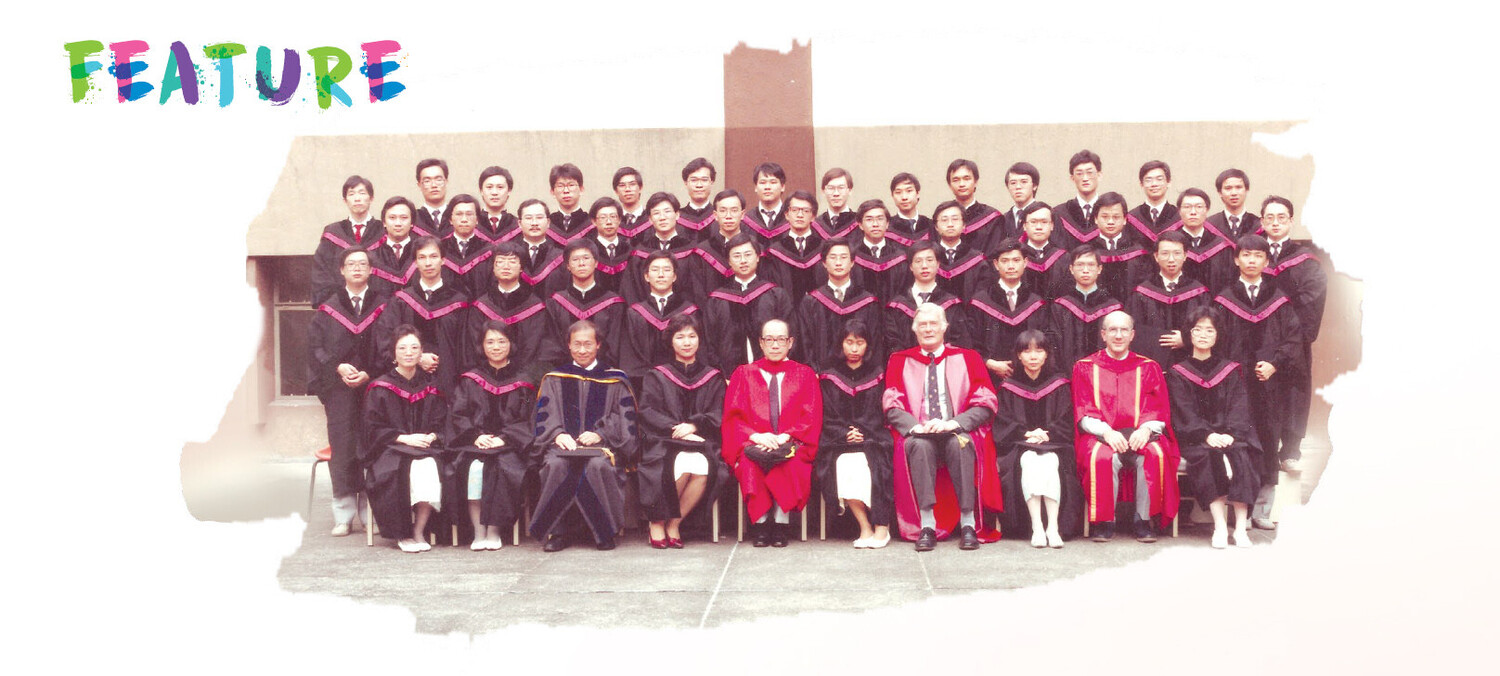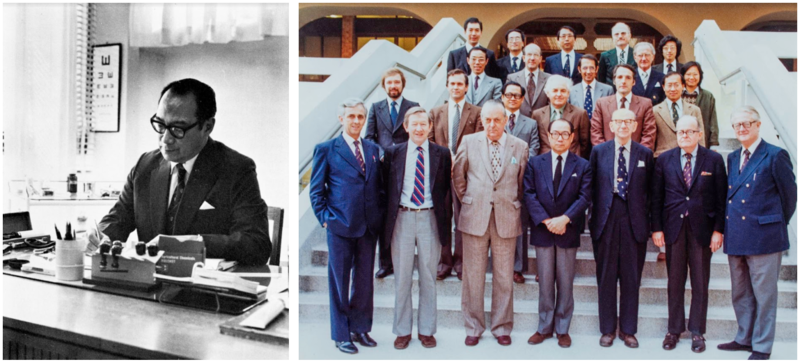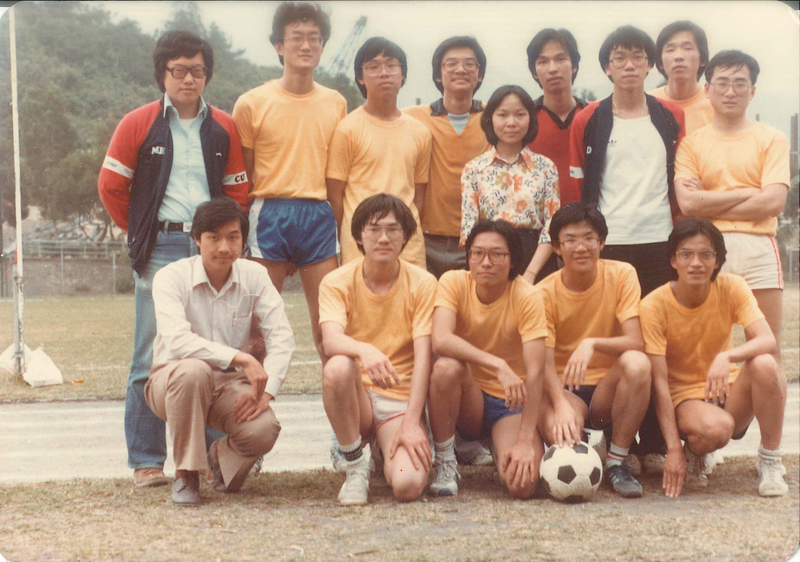
When CU Medicine’s inaugural class of 60 undergraduate students arrived for their first semester in 1981, they knew there would be teething problems ahead. After all, the brand-new Faculty of Medicine had yet to be recognised by the General Medical Council (official GMC accreditation did not come until 1987), and the Prince of Wales Hospital – what would become the faculty’s dedicated teaching hospital – was still being built.
Until it was ready, Founding Dean, late Professor Gerald CHOA, had to set up clinical tutorials at the United Christian Hospital. This meant that for these very first students, much of their learning took place in a makeshift classroom inside a container at the United Christian Hospital carpark.
But nothing could have prepared this “container generation” of aspiring doctors, as they came to be known, for the intense and unforgettable days to come.
The container became their classroom, nap room, and home base for those on call. Freezing cold in the winter and stuffy in Hong Kong’s humid summers, conditions in the container were less than ideal – often prompting the students to log extra studying time in the air-conditioned hospital wings instead.

Despite the prickly start, “we were the lucky ones,” said Professor WING Yun Kwok, currently Chairman, Department of Psychiatry, Faculty of Medicine at the Chinese University of Hong Kong (CUHK). Fondly, he recounts the typical early mornings where he and his classmates would board a coach bus and travel to their lessons together.
“Some of us slept, others studied, but more often, we sang together. Hits by Sam HUI, Michael KWAN; you name it,” he said. Those bus rides came to hold some of their most poignant memories. There, they chatted, bonded, sharing experiences and becoming fast friends. Without any upperclassmen to light the way forward, the group counted on each other for support, tackling tricky homework problems and unfamiliar medical vocabulary together. “We jokingly dubbed ourselves ‘CU Self- Learners’ for the level of independence and resilience required of us as the inaugural class,” said Professor WING.
But of course, they were more “self-starters” than “self-learners”. Both in and outside of the classroom, the students were taken under the wing by an international team of founding professors led by the late Professor CHOA, who envisioned the fledgeling medical school as a breeding ground for globally-minded, caring medical professionals.

“We were like a big family, and Professor CHOA was like our father,” said Professor Linda LAM, Professor in Psychiatry at CUHK Faculty of Medicine. “He held us to a high standard and taught us everything, from our gait and the right way to hold a pen, to choosing our specialisations.”
Professor CHOA believed in cultivating a holistic mix of medical qualifications to truly serve the needs of Hong Kong. “CU Medicine never prioritised one specialisation over another. Rather, it focused on balance and preparedness for serving the society. Thinking back, it was a bold and visionary move,” said Professor WING.
“Our professors encouraged us to pursue less popular fields in a city already abound with surgeons and physicians. Psychiatry was definitely not a common choice back then, but the world has changed, and the field has rapidly expanded in pertinence for addressing modern needs,” said Professor LAM.
As recently as the COVID-19, Avian Flu and Ebola outbreaks, there were ‘86 graduates on the frontline, travelling to disease epicentres or local quarantine centres to offer their help. “That’s what doctors do. They serve anywhere they are needed, in Hong Kong or beyond. I would love to see the future generations of doctors keep this spirit alive,” she added.
Dr. Loar MO, Consultant Geriatrician & former Chief of Service, Department of Medicine, Yan Chai Hospital, says this focus on care and service was deeply entrenched in CU Medicine’s culture from the very beginning. He remembers one particular professor who put this in context with amazing clarity: “He asked us to imagine each patient as our parent. What would we do if it were our own beloved suffering from the same illness? Then that is what we should do for the patient. I have taken this to heart and been guided by it all these years.”
When he wasn’t studying or attending tutorials, Dr. MO was the official photographer for the first CU Medicine annual publication Pacemaker, which he coined. With little prior experience, Dr. MO toted his newly purchased Olympus 135mm lens camera to capture the high-octane lives of his fellow container friends. Today, his yellowing copies of Pacemaker document countless glorious moments for the class of 1986, like the multiple university championships they took home from swimming and running events, and the many hikes, outings, parties, barbecues, and trips they enjoyed together.
The colourful student life at CU Medicine was in no small part the effort of Dr. Scotty LUK, currently Director of the University Health Service (UHS) at CUHK, and the first president of the University’s Medical Society. Harbouring a playful spirit himself, his agenda ensured that fun was always part of the equation.

“We were spirited, athletic, and very close. There were many star athletes among our group,” said Dr. LUK, who once clocked a 58-second finish for his leg in a 4 x 400m relay. Dr. Matthew LO, currently Co-director of Endocrine and Diabetes Centre and Deputy Director, Department of Health Assessment, Hong Kong Sanatorium & Hospital, a badminton player and one of the most enthusiastic sportsmen in the class, said, “Our sporting events were almost always full class affairs. Some of us were more active than others, but we all joined the activities. We just wanted to spend time together.”
With that much energy to spare, life was always abuzz in the container, in the students’ dormitories, or on their nearby stamping grounds. They could often be seen playing football in the evenings, cooking up regional dishes, splashing around in water fights or even huddled together attempting a human pyramid. It didn’t matter that their facilities were basic and the coursework was challenging. As long as they were together, they were happy.

And challenging indeed it was. Even as they revelled in their exciting campus life, the students never lost sight of their goal: to become knowledgeable, qualified doctors. As the Faculty of Medicine pursued GMC Accreditation, they came under pressure to meet the stringent assessment standards in their first and second years. Even after passing the assessment, the requirement to attend frequent attachment programmes at different hospitals and increasingly intricate clinical topics proved demanding. “Burning the midnight oil at the residential hall study room became a regular part of my fourth year,” said Dr. LUK.
Dr. LO was no stranger to this kind of stress. Joining CU Medicine from a Chinese-language secondary school, he spent much of his first year acclimatising to all the new English terminology from his biochemistry and human anatomy courses. “There was no Internet, no Google. It was just me and my dictionary, and it was not uncommon for me to sit in my room for hours just to work out the vocabulary,” he said.
But both doctors agree that the difficulties of undergraduate study were no match for the realities of medical practice, something they realised after receiving their white coats in 1986. “Studying and practising are two different things,” said Dr. LUK. “In practice, we must prescribe treatment best matched to a patient’s particular condition and needs, not necessarily what we think we know from our books. It’s not always easy to do, but our days at CU laid the foundation for these principles.” Professor WING echoed these sentiments: “CU Medicine is not just a medical school, but a growth institution where students soak up not only knowledge but also the values of ethics, grit and resilience. I know that it will continue to provide an environment where every student can grow to their fullest potential.”
Over the last four decades, building on the hard work and passion of these doctors and the generations that followed, CU Medicine has gone from strength to strength, innovating and making breakthroughs across medical disciplines. The doctors from the container generation may each have taken very different paths, but they are forever bonded by their shared experience in those formative years. Indeed, when they arrived for their first semester in 1981, they never imagined they would leave with the lifelong friendships of their study buddies, fellow athletes, and inspiring professors. It was even less likely that they knew they would still be there for one another 40 years on, exchanging daily messages in their WhatsApp group, meeting every few months for meals or mahjong games, and continuing to shape the legacy of CU Medicine together.

